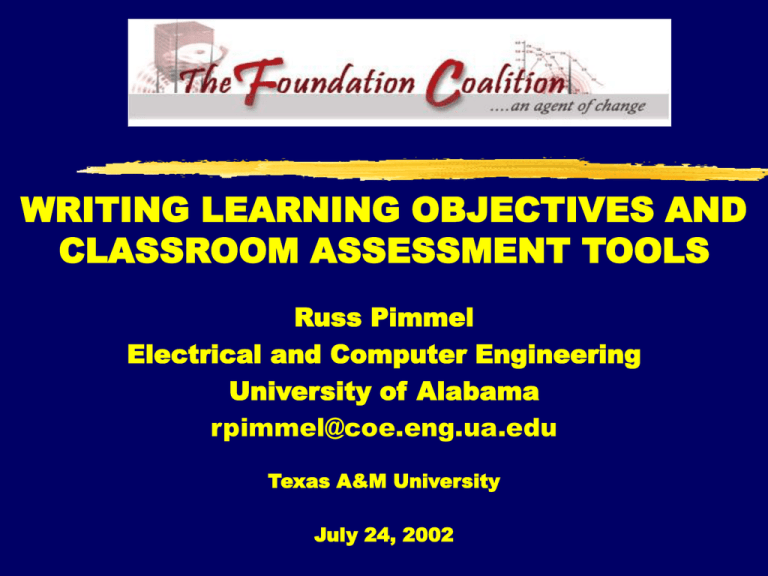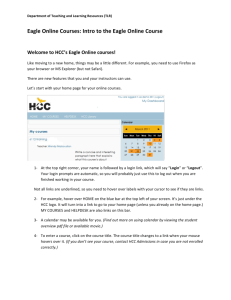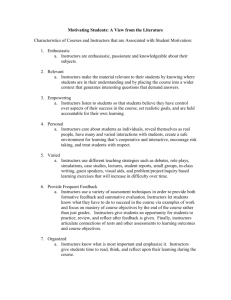teaching workshop # 2 - Foundation Coalition
advertisement

WRITING LEARNING OBJECTIVES AND CLASSROOM ASSESSMENT TOOLS Russ Pimmel Electrical and Computer Engineering University of Alabama rpimmel@coe.eng.ua.edu Texas A&M University July 24, 2002 Workshop Objectives, Schedule & Format • • • • Participants will gain experience in writing Learning objectives Classroom assessment tools Workshop intended for beginners Workshop schedule One hour on learning objectives One hour on classroom assessments Workshop format “Working” workshop ½ to ¾ of time in team and individual activities Learning Objectives Schedule -- Learning Objectives • • • • • Presentation Learning objectives Team Exercise Write guidelines for learning objectives Individual Exercise Write learning objectives Team Exercise Review individual objectives Individual Exercise Rewrite learning objectives Learning Objective Pre-assessment • Write a one-sentence answer to the following question: What is a learning objective? Learning Objective for Session At end of session, participants will be able to: Define a learning objective • An instructional objective Discuss the importance of learning objectives in the teaching-learning process Write learning objectives for their courses Web Sites -- Learning Objectives • • • • www.hcc.hawaii.edu/intranet/committees/FacDevCom/guidebk/teachtip/writeobj.htm sheridan-center.stg.brown.edu/publications/SyllabusHandbook/syllabus.shtml#coura ublib.buffalo.edu/libraries/projects/tlr/importance.html faculty.washington.edu/krumme/giodes/bloom Importance of Objectives University of Buffalo Web Site ublib.buffalo.edu/libraries/projects/tlr/importance.html Purpose of Learning Objectives • • Communicate expectations for a course Provide a context for what will be learned ublib.buffalo.edu/libraries/projects/tlr/importance.html Objectives and Students • • Objectives help students Clarify their personal goals Provide framework for measuring their success. Reduce their anxiety Improve their studying effectiveness Objectives help instructors Guide preparation of classroom material Make homework assignments Aid in test design Modified from ublib.buffalo.edu/libraries/projects/tlr/importance.html Form of Learning Objectives • • Write objectives as student outcome statements Objectives should answer the questions "What must students do to prove that they have succeeded?" "What should students be able to do as a consequence of instruction?" ublib.buffalo.edu/libraries/projects/tlr/importance.html Elements of an Objective • Objective must contain three basic elements: Verb describing an observable action Conditions of this action • “When given x you will be able to..." Level of acceptable performance ublib.buffalo.edu/libraries/projects/tlr/importance.html Constructing a Syllabus – M. Woolcock – Brown University Verbs for constructing concrete objectives: analyze compute classify compare appreciate contrast demonstrate direct derive discuss display evaluate identify infer integrate justify list understand grasp report respond state synthesize name collaborate define designate know interpret organize solicit explain Modified from sheridan-center.stg.brown.edu/publications/SyllabusHandbook/syllabus.shtml#coura Constructing a Syllabus – M. Woolcock – Brown University Verbs for constructing concrete objectives: analyze compute classify compare appreciate contrast demonstrate direct derive discuss display evaluate identify infer integrate justify list understand grasp report respond state synthesize name collaborate define designate know interpret organize solicit explain Modified from sheridan-center.stg.brown.edu/publications/SyllabusHandbook/syllabus.shtml#coura Learning Objectives Verbs for Categories in Bloom’s Taxonomy • • • • • • Knowledge Define, describe, list, reproduce, enumerate Comprehension Classify, explain, discuss, give example, summarize Application Determine, develop, compute, chart, utilize Analysis Correlate, diagram, distinguish, outline, infer Synthesis Adapt, combine, compare, contrast, design, generate Evaluation Compare & contrast, critique, justify, conclude Modified from faculty.washington.edu/krumme/giodes/bloom Some Personal Observations Complex Versus Simple Objectives • One complex objective versus several simple ones? High-level versus low-level objectives Example • One complex objective (4 or 5 weeks of classes) “Given a verbal description of a digital module, develop an implementation using any of 7 different logic devices” • 15 to 20 simpler objectives (1 or 2 per class) “Given a verbal description, draw the truth table” “Given a truth table, obtain a minimum-cost equation” … “Draw the the NAND-gate implementation for an equation” Comparison Of Complex & Simple Objectives • • Multiple simple objectives More manageable “chunks” for students Explicit objective(s) for each class Simple (more manageable) homework problems and test questions Single complex objective Student's attention directed to the overall process • May lead to higher level learning Students must deal with complexity Students must subdivide problem on their own Advantages Of Simple Objectives • Advantages of simple objectives are more important in Large classes rather than small classes Introductory courses rather than advanced courses How To Deal With “Understand” In Objectives • • How do you write objectives when you want students to “understand” a complex concept, system, or process Identify specific tasks that indicate “understanding” Specify objectives for each task How To Deal With “Understand” In Objectives -- Example • • • In our computer architecture course we want students to “understand” a sample architecture made up of several modules What would students be able to do if they “understood” Objectives – Students should be able to identify: All the modules and interconnecting signals Modules involved in a given system-level operation Output values for a given input values for each module Sub-module changes given a system level change … Writing Objectives – Piecemeal Approach • • • Writing low-level objectives for a whole course may be overwhelming Use a “piecemeal” approach Write your lectures and define the homework as usual After each class -- write down what you expect the students to be able to do These become a list of objectives • Give them to the students before each exam • Use them to write the exam As semester progresses -- may become comfortable writing the objectives before you prepare your lecture Evolving Objectives • • In a 3-credit course I started with over 100 objectives Four offerings later -- down to about 50 Eliminated peripheral “stuff” that was not central Broadening, informational, perspective material Objectives and Homework Assignments • • Homework assignments should match objectives Students need to practice and explore the skills, knowledge, and attitudes defined in objectives Frequently require supplementary homework problems In some of my courses • 1/3 of homework is from textbook • Rest are supplementary problems With well defined objectives • Writing homework problems is straightforward • Same is true for exam questions Student’s Use Of Objectives • • • Survey in 400-level required course Did you find the objectives helpful? Yes --- 52 % No ---- 48% Did you read the objectives? Frequently ------ 22 % Occasionally -- 37 % Never ------------- 41 % Team Exercise Guidelines For Learning Objectives Strategies For Team Operation • • Assign team roles & follow through on responsibilities Coordinator -- Coordinates discussion & develops consensus Recorder -- Writes down the ideas & reports them Gatekeeper -- Keeps the team on the subject Timer -- Makes sure the team stays on schedule With smaller teams – combine gatekeeper & timer Strategies For Team Operation • • • Be positive, supportive, and cooperative Limit critical or negative comments Be brief and concise in discussions Avoid lengthy comments, stories, or arguments Stay focused Team Roles • • For first exercise Coordinator – Individual with largest class last semester Recorder/Reporter – Individual on left of coordinator Gatekeeper/timer -- Individual on left of recorder Timer -- Individual on left of gatekeeper Roles rotate clockwise on subsequent exercise Guidelines For Learning Objectives • • Task Write 3 or 5 guidelines for good learning objectives • What are the common features? • What should objectives look like? Think of guidelines as specifications Methodology Brain storm individually -- 2 minutes Establish consensus as a team -- 5 minutes Report team results -- 3 minutes Revise guidelines as a team-- 2 minutes Individual Exercise Writing Learning Objectives Writing Learning Objectives • • • • Individually write a set of objectives for a topic representing a few classes Something that you recently did in class Follow your team’s guidelines Questions to consider about your objectives Do they define student behavior? Are they observable, measurable? Can you write homework problems & exam questions? Are they consistent with the instructor’s intent? 5 minutes Team Exercise Reviewing Learning Objectives Reviewing Learning Objectives • • • Review each other’s objectives Questions to consider in reviewing objectives Do they follow your team’s guidelines Do they define student behavior? Are they observable, measurable? Can you write homework problems & exam questions? Are they consistent with the instructor’s intent? 15 minutes Individual Exercise Revising Your Learning Objectives Revising Your Learning Objectives • Rewrite your learning objectives based on your team’s review • Report on biggest improvement • 5 minutes Learning Objectives Post-assessment • Write a one-sentence answer to the following question: What is the “muddiest point” about learning objectives? • (What is the most confusing point?) Classroom Assessment Schedule -- Classroom Assessment • • • • • Presentation Classroom assessment tools Team Exercise Write guidelines for classroom assessment tools Individual Exercise Write classroom assessment tools Team Exercise Review individual classroom assessment tools Individual Exercise Rewrite classroom assessment tools Classroom Assessment ---- PreAssessment • Write a one-sentence answer to the following question: How would you determine whether or not your class as a whole learned what you taught that day? Learning Objective for Session on Classroom Assessment • At end of session, participants will be able to: Define several classroom assessment tools Discuss the importance of using classroom tools in the teaching-learning process Write assessment tools for their classes Web Site -- Classroom Assessment • • • www.hcc.hawaii.edu/intranet/committees/FacDevCom/guidebk/teachtip/assess-2.htm www.hcc.hawaii.edu/intranet/committees/FacDevCom/guidebk/teachtip/assess-1.htm www.siue.edu/~deder/assess/catmain.html Types Of Assessment • • • • Assessment used in many contexts Classroom assessment Concerns your performance Performance assessment Concerns individual student’s performance Outcomes assessment (ABET-type assessment) Concerns program’s performance Types Of Assessment • • • Classroom assessment Question -- How effective was a lecture, assignment, lab? Tools -- One-minute paper, student survey Performance assessment Question – Did a specific student achieve the learning objectives? Tools -- Exams, reports, presentation Outcomes assessment (ABET-type assessment) Question -- How well did a group of students achieve a set of objectives (outcomes) in a program or course? Tools -- Standardized test, alumni & employee surveys Classroom Assessment Techniques Thomas A. Angelo and K. Patricia Cross From Classroom Assessment Techniques, A Handbook for College Teachers, 2nd Ed. University of Hawaii Web Site www.hcc.hawaii.edu/intranet/committees/FacDevCom/guidebk/teachtip/assess-1.htm Classroom Assessment • • Two fundamental questions: How well are learners learning? How effectively are teachers teaching? Deals with better learning and more effective teaching Provides feedback about effectiveness as teachers • How students learn • How they respond to particular teaching approaches. Gives students a measure of their progress as learners Modified from www.hcc.hawaii.edu/intranet/committees/FacDevCom/guidebk/teachtip/assess-1.htm Incorrect Assumptions About Teaching & Learning • • Instructors assume students learn what they teach Tests and term papers provide disappointing evidence to the contrary Students have not learned as much or as well as expected Gaps between what was taught and what was learned • Sometimes considerable gaps • Instructors notice gaps too late to remedy the problems • Classroom assessment can uncover gaps earlier www.hcc.hawaii.edu/intranet/committees/FacDevCom/guidebk/teachtip/assess-1.htm Getting Started In Using Classroom Assessment Techniques --Three Steps • • • Planning Select one, and only one, of your classes • Choose a simple and quick technique Implementing Make sure the students understand the procedure Analyze student’s responses as soon as possible Responding -- “Close the feedback loop“ Tell students what you learned and what you will do about it • Motivates students to become actively involved www.hcc.hawaii.edu/intranet/committees/FacDevCom/guidebk/teachtip/assess-1.htm Classroom Assessment – Five Suggestions • • • • • Don’t use any technique that does not appeal to you Don't make it into a self-inflicted chore or burden. Try it yourself before you use it with students Allow more time than you think you will need To carry out the assessment To respond to it Make sure to "close the loop" Let students know • What you learned from their feedback • How you and they can use that information to improve learning www.hcc.hawaii.edu/intranet/committees/FacDevCom/guidebk/teachtip/assess-1.htm Classroom Assessment Technique Examples Thomas A. Angelo and K. Patricia Cross From Classroom Assessment Techniques: A Handbook for College Teachers, 2nd Ed. University of Hawii Web Site www.hcc.hawaii.edu/intranet/committees/FacDevCom/guidebk/teachtip/assess-2.htm Examples of Assessment Techniques • • Background Knowledge Probe Students respond to short-answers or multiple-choice questions • General information on their level of preparation Minute Paper (most widely used) • Students write brief response to • "What was the most important thing you learned during this class?" • “What important question remains unanswered?“ www.hcc.hawaii.edu/intranet/committees/FacDevCom/guidebk/teachtip/assess-2.htm Examples of Assessment Techniques (Cont.) • Muddiest Point (simplest technique, remarkably efficient) • Students jot down a quick response to one • "What was the muddiest point in ....... ?” • A lecture, a discussion, a homework assignment • One-Sentence Summary • Students answer the questions "Who does what to whom, when, where, how, and why?" (WDWWWWHW) • Synthesize answers into a simple, informative, grammatical sentence. www.hcc.hawaii.edu/intranet/committees/FacDevCom/guidebk/teachtip/assess-2.htm Examples of Assessment Techniques (Cont.) • What's the Principle? • Students state the principle that best applies to a few problems www.hcc.hawaii.edu/intranet/committees/FacDevCom/guidebk/teachtip/assess-2.htm Some Personal Observations Relating Student Performance On Exams To Objectives • • Write exam using objectives Select objectives for exam questions from lsist • Many objectives -- test questions represent a sample • Exam question may involve more than one objective • Use some “hard” and some “easy” questions Identify questions (& objectives) a high percentage missed Review idea in class -- give additional work Modify lecture, reading, or homework for future Change the objective Assessment With Cooperative Learning In-class Exercises • • Examine students work during the in-class exercise If all have a good approach -- may be wasting time If all are lost -- may need more explanation If one-half to two-third have a good approach -- level and pace are right Collect and show a few solutions to in-class exercises If all have correct approach -- may be wasting time If all are wrong -- may need more explanation If one or two are correct -- level and pace are right “One-Minute Papers • • Common questions What one thing should be changed about ____? What one thing should not be changes about ____? What do you think about ____? What is the “muddiest’ point about ____ ? Ask about Course or lecture Text or chapter Assignment or test Teaching style or class activity Some Colleagues’ Observations Informal Assessment Techniques • General Guidelines Keep them anonymous Use then frequently – better feedback Close the loop • Let students know results of the process David Cordes Informal Assessment Techniques Daily Activities • One-minute paper At the end of the lecture, ask students for: • The most important topic that we covered today • The one topic you are still confused about Single sheet of paper, no names Can read on the way back to the office • Look for “common problems” • Look for “did they understand my focus?” David Cordes ME 360 - Plus / Delta Assessment #1 • • • On one side of “sticky” pad Put a “+” in upper left hand corner What is something that worked well or made more sense in lab this week? On other side of “sticky” pad Put a “D” in upper left hand corner What is something that could have been done better in lab this week? “Stick” on the door on your way out Joey Parker ME 372 - 1st Day of Class • • • What are a valid set of units for a mass moment of inertia? (Dynamics concept) What is the difference between a capacitor and a resistor? (Circuits concept) What is the equation of the straight line that passes through the points X=2, Y=7 and X=7, Y=2? (Math concept) Joey Parker Team Exercise Guidelines For Assessment Tools Guidelines For Writing Assessment Tools • • Task Write 3 to 5 guidelines for good assessment tools • What are the common features? • What should they look like? • Do all guidelines have to apply to all tools? Think of guidelines as specifications Methodology Brain storm individually -- 2 minutes Establish consensus as a team -- 5 minutes Report team results -- 3 minutes Revise guidelines as a team -- 2 minutes Individual Exercise Writing Assessment Tools Writing Assessment Tools • • • • Individually write a set of assessment tools for a class or a topic representing a few classes Follow your guidelines Consider the following questions about your tool Can your students understand the task? Can your students do the task quickly? Can you analyze the results quickly? Can you summarize and report the results easily? Does it assess student learning? 5 minutes Team Exercise Reviewing Assessment Tools Reviewing Assessment Tools • • • Review each other’s objectives and assessment tools Consider the following questions Does the tool follow your guidelines? Can your students understand the task? Can your students do the task quickly? Can you analyze the results quickly? Can you summarize and report the results easily? Does it assess student learning? 15 minutes Individual Exercise Revising Your Assessment Tools Revising Your Assessment Tools • Rewrite your assessment tools based on your team’s review • Identify the major improvement • 5 minutes Learning Objectives Post-Assessment • Write a one-sentence answer to the following question: What is the muddiest point about classroom assessment? Workshop Objectives, Accomplishments & Action Items • • • Recall objectives At end of session, participants will be able to define, discuss, & write • Learning objectives for their courses • Assessment tools for their classes Workshop provided a structure for & experience in writing Learning objectives Assessment tools Your charge – In one of your courses next semester use Learning objectives Classroom assessment tools Questions? WRITING LEARNING OBJECTIVES AND CLASSROOM ASSESSMENT TOOLS Russ Pimmel Electrical and Computer Engineering University of Alabama rpimmel@coe.eng.ua.edu Texas A&M University July 24, 2001




